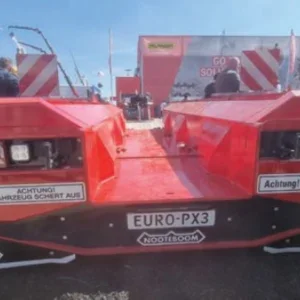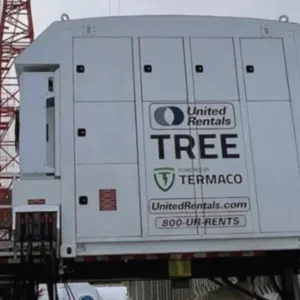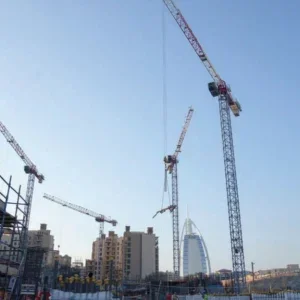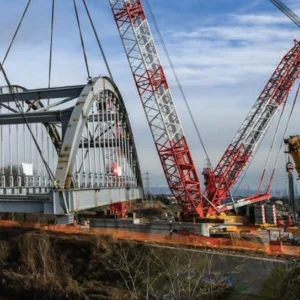The UK firm of Fagioli PSC, based near London, performs the heavy lifting required by the international transport company Fagioli Group, based in northern Italy. The UK firm employs 45 people based in the UK, but also works out of the parent group’s offices in Houston, Texas, Dammam, Saudi Arabia, Mumbai, India, Singapore and Seoul, Korea. Fagioli Group’s 2002 turnover – the latest figure available – was Euro 147m. Last year’s turnover for PSC was £12m (Euro 17.25m).
PSC specialises mainly in strand jacking, and owns ‘in excess of 500’ jacks, says operations director Stephen Taylor, which he claims is the largest stock of any lifting contractor. The company originally rented post-tensioning equipment for bridges (PSC stands for pre-stressed concrete). Because many jobs required both special transport and heavy lifting, Fagioli and PSC Heavy Lift (as it was then known) were a natural fit, and Fagioli bought the company in 1999.
Mumbai bridge lift
It recently supplied strand jacks to its sister company Fagioli PSC India, which is a joint venture with Gemini Power Hydraulics Pvt Ltd of Mumbai.
During the past century many short span bridges have been built throughout India to provide river crossings for railway lines, roads and for other purposes. Government plans to construct a modern national highway network, a national gas pipeline grid and extensive piped water and oil transport facilities will ensure the need to build many more short span bridges in future.
At a river crossing near Mumbai in western Maharastra state, Fagioli PSC India recently has completed a steel box girder bridge lifting project for Thane Municipal Corporation using strand jacks. The bridge is designed to carry a 24 inch diameter cast iron water pipe that transports water from dam reservoirs in the Ghat Hills in northwest Maharastra to provide fresh water to Mumbai, India’s largest city and leading business centre.
Thane Municipal Corporation decided to build the box girder bridge after an existing short span bridge carrying a water pipe 300 metres further down stream on Thane Creek was found to be too weak to carry a second water pipe.
Thane Municipality awarded the box girder bridge construction contract to Ashoka Buildcon Ltd, while Stup Consultants Ltd were appointed as project consultants.
The first problem that had to be solved was how to build the box girder bridge to span the creek.
Three options were considered, according to Rajiv Sethi, managing director of Fagioli PSC India. The first option was to assemble the box girder bridge and then use either four or eight cranes to lift the box girder structure into position. This would require crawler cranes from 120t to 200t in lifting capacity equipped with long booms able to lift from a distance, and large enough to cope with the stress of the box girder structure bending during the lift. In addition, a 200t capacity barge mounted crane positioned on the creek also may have been needed to assist with the lift.
Option two was to build the box girder bridge in four 12 metre long sections. Each section would be lifted one at a time into its intended position and then secured in midair by welding or bolting the sections together. This option would involve using two 75t or 100t crawler cranes, one at either end of the bridge on either side of the creek to lift the two end sections into place. In addition, a third 75t to 100t capacity barge mounted crane would be needed to lift the two centre box girder sections into place for bolting or welding.
Although option two involved using fewer cranes than the first option, the hire time for cranes used in option two would be much longer (and the rental cost higher) than for the cranes used in option one which involved a single lift as option two required four separate lifts.
The third option was to use strand jacks. Eventually this was the option chosen. ‘Strand jacking was chosen for cost reasons and the shorter project time which also affects costs,’ Sethi said. ‘Strand jacks provide alternative lifting that cranes cannot do for various reasons.’
‘Option one was the most expensive, while option two was cheaper but required a longer time frame of six to eight weeks,’ Sethi said. ‘The third option, using strand jacks, was done in one day.’
Stup Consultants suggested that the entire box girder structure should be constructed at ground level on site and then lifted in one piece to the planned elevation using four strand jacks. Stup’s confidence in the Fagioli PSC strand jack capability resulted from a previous project when Fagioli PSC India had lifted a 1,200t roof structure for an Air India hangar for which Stup Consultants had been the engineering consultant. The Thane bridge box girder structure is 51m long, 11.6m wide and 7.5m high. The steel truss weighs 180t.
Four 50t strand jack units were used for the Thane bridge lift. Two strand jacks were mounted at either end of the bridge crossing on bridge column pier caps. Fagioli PSC India dispatched a team of 10 engineers and technicians to the project site. The strand jacks took one day to assemble and half a day to take down after the lift was completed.
‘The box girder section was lifted at four meters per hour. The lifting job actually took two hours,’ Sethi said. ‘Strand jacks are probably the fastest way to erect box girder bridges. They are economical to use as cranes cost a lot to be transported to remote sites while strand jacks can be loaded onto a pickup truck.’
DSCF0013.JPG It took two hours for strand jacks to lift this 180t steel truss bridge, once everything was set up.
DSCF0018.JPG The jacks were mounted on a girder on bridge column pier caps.
Power plant problem
Although the company has carried out four power station steam boiler drum assembly jobs in India, it recently completed its first boiler drum rescue.
India’s state-run National Thermal Power Corporation (NTPC) operates coal, oil and gas-fired power plants to supply electricity to the national grid. It appointed Bharat Heavy Electricals Ltd (BHEL) as main contractors to build Talcher coal-fired power station in Orissa state in eastern India.
During construction of the plant’s boiler house, BHEL employed a conventional winch to lift a 226 metric ton cylindrical steam boiler drum to its required position 85m above the ground where U-bolts were used to secure the drum. The boiler drum occupies this position above the boiler so it can be fed with piped steam from the boiler below.
However, during a final plant acceptance inspection prior to the power plant being handed over to NTPC, a team of NTPC inspectors discovered that nuts on two U-bolts securing the boiler drum to the boiler house roof beam structure had not been completely tightened. As a result there was a 20mm gap between the boiler drum’s actual position and its final intended position.
‘The U-bolt nuts were not completely tightened and so the boiler drum was not properly installed,’ Sethi explained. ‘With vibration the nuts could have come further undone.’
Fagioli PSC India was contracted to lift the drum into its final to allow the U-bolt nuts to be completely tightened.
Four 50 ton centre hole strand jack units supplied by Fagioli PSC of the UK were used for the lift. Preparation for the lift took one day to mount the strand jacks on the boiler house roof. Dismantling the equipment once the lift was completed involved a further day’s work.
The actual lift lasted 40 minutes, Sethi said. After the steam boiler drum was lifted 20mm to its correct elevation, four nuts were then fully tightened on the two large U-bolts.
‘The client chose strand jacks as it would have been very difficult, time consuming and cumbersome to restring the winches,’ Sethi said. ‘Also, using a winch is inexact while using a crane would have been very expensive as it would have required a 90 metre boom which meant a 500 ton crane to lift the boiler drum from above, through the roof. Strand jacks are cheaper. They were just 20% of the cost of using a crane.’
IMAGE_3.TIF caption
Fagioli PSC India’s strand jacks took the load off two loose U-bolts so that they could be tightened, removing the gap shown being measured here
The longest bridge
Lately Fagioli PSC has been busy in the UK, with five major lifting contracts have come through in 12 months, all in the south of England: the Spinnaker Tower in Portsmouth (see CT June p9); a passenger bridge at London’s Gatwick airport; the arch at London’s new Wembley football stadium; and at London’s Heathrow airport, it is lifting up a new air control tower, and raising the roof of the new Terminal 5 building. For George Wilson, PSC project manager, it was a chance to work on home soil. ‘I haven’t worked in the country for 14 years,’ he says.
The Gatwick airport job required the company to raise one of the longest loads it has ever lifted – a 140m section of passenger walkway – to a height of 22m.
A 140m section of a passenger walkway has been lifted whole into position 22m off the ground.
The bridge, 197m long including two back spans, crosses a plane taxiway at the airport to connect a new passenger facilities with an existing terminal building. With main span of 125m, it is high enough and wide enough to admit the largest airplane in service, the Boeing 747-400, between its two Y-shaped pylons.
The Gatwick bridge was assembled from only five parts: the main span, two end spans and two Y-shaped pylons. The few parts kept the assembly job to 10 days. Building the bridge in situ would have closed the taxiway for six to seven months, estimates Wilson. Bridge designer Arup estimates boring a tunnel would have required moving 81,000t of earth and 20,000 tonnes of concrete. The bridge will save 50,000 bus loads a year, according to Arup. The only other passenger bridge crossing an active airfield is a 111m pedestrian bridge at Denver International Airport, USA.
The bridge was built in a yard 1.5km (one mile) away, outside of the airport. To save rigging time, the bridge was constructed on top of the main 1.5m-high steel lifting beam, and two lifting towers at each end of the beam were also assembled there. Then the whole load – main span, lifting towers and lifting beams – was rolled into place using 120 axles of self-propelled modular transport (SPMT) trailers, 60 at each end, 12 on each of five individual trailers brought in from Italy, head of the firm’s transport operations.
To guard against twisting the bridge during transport – a significant risk in such a long structure – the team relied on the SPMTs’ hydraulics. They laid tubes of coloured water, scaled-up versions of spirit levels, across the trailers. ‘It’s simple, but it’s absolutely foolproof,’ Wilson says.
The two lifting towers were also designed specially for transport. Each tower consists of four legs. From the side, the towers resemble a triangle – the distance between the uprights tapers toward the top. They are connected by a steel roof structure at the top, which also supports a steel lattice beam that runs about 15m to the pair of legs on the other side of the bridge. This sheerleg design kept the lifting towers stiff and stable. But it did require the firm to build a total of four bases, two tower tops and a cross piece. ‘We hope we can use them again,’ Wilson said. Height under cross beam, the maximum lifting height, was 32m.
Once the bridge section and lifting towers were offloaded from the trailers, the lifting could begin. Each tower had four 450t centre-hole jacks with 27 strands each to raise the lifting beam that supported an end of the bridge.
While this nearly 24-hour lift was taking place, the trailers returned to the lay-down yard for the pylons, which had been constructed in their vertical positions. Once the pylons were in position underneath the span and above their piled foundations, the bridge section was lowered until a socket in the bottom of the bridge lined up with one in the top of the pylons. Main steelwork contractor Watson Steel Structures pinned, and then bolted, bridge and pylons together. Then the strand jacks lifted bridge and pylons high enough to be able to drive out the trailers from underneath. Although this was the heaviest point of the lift – the jacks supported a total of 2,800t – the system still had a safety factor of 3.5, Wilson says.
The pylons were then lowered until they touched the ground, and then held until engineers could make sure that the bridge geometry was exactly correct. That surveying work took the bulk of the 10 days of taxiway closure.
PSC used two systems to make sure the bridge did not twist as it rose. When the bridge was first picked up, engineers surveyed the lifting beams to make sure they were level, and then used that measured load in each cylinder for the rest of the lifting operations. A computer-controlled monitoring system made sure that the strand jacks were lifting at the same height, within a pre-set error limit of 5mm.
After the bridge was set down and the runway re-opened, Fagioli PSC could focus on the two back spans that connect the bridge to the elevator and service cores at either end. These 20m, 120t unfinished bridge elements were ‘tricky’ to lift because there was no room to spare at either end. Each back span’s frame rests inside the core building and the main bridge span, and the cores and the bridge were already in place. To manoeuvre each back span in place, Fagioli set up two pairs of 100t capacity strand jacks, one pair on the top of the core building and one pair on the top of the bridge and connected the strands to each of the four corners of the back span. Then it lifted the span level, attached seven bars to hang an escalator from, and then lifted the core end about four metres higher than the bridge end, so that it stabbed into the core about a metre. Then, as the back span’s bridge end was raised so the span became level, the core end came to rest on skids. Then the back span was skidded out about half a metre into the bridge section.
The taxiway reopened at the end of May and is expected to open for passengers in early 2005.
Architect Wilkinson Eyre and engineering group Arup planned the bridge for airport owner BAA. Primary construction contractor was Mace. Construction and engineering firm Cleveland Bridge designed the original construction concept.
01__0001.tif
Lifting contractor Fagioli PSC lifted the 1,200t bridge span from underneath with a total of eight 450t capacity strand jacks.
05__0005.jpg
The 128m main span is wide enough, and high enough, to let a Boeing 747-400 pass beneath. Photo: Nick Wood
07__0007.tif
Maximum lift height was 32m






